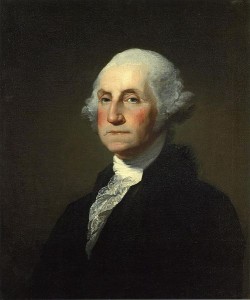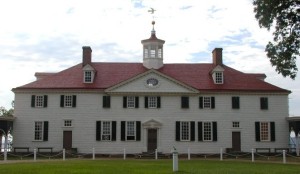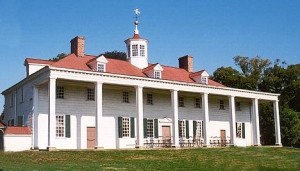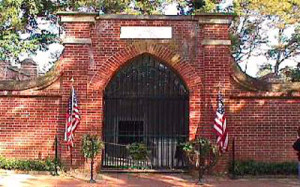We visited Mount Vernon while on a road trip through Virginia to Washington D.C. back in 2002. Mount Vernon is located along the Potomac River in northern Virginia and 16 miles south of Washington D.C. If you are visiting Washington D.C., we highly recommend the short trip out to Mount Vernon, especially if you have school-aged children. It is a wonderful way to learn about the life of George Washington and the history of our country.
 George Washington (Born: February 22, 1732 Died: December 14, 1799) was the Commander-in-Chief of the American forces during the Revolutionary War and the first President of the United States. Washington inherited Mount Vernon in 1754 and even when he was away at war he personally oversaw every detail of the design, construction and decoration of the home and the plantation expansions reflect his status as a Virginia gentleman. He and his wife Martha lived together at Mount Vernon for more than 40 years. Today, Mount Vernon covers nearly 50 acres that were once Washington’s extensive plantation. Visitors can tour Washington’s home and tomb, a new visitor center and museum, beautiful gardens and a demonstration farm with a reconstructed slave cabin.
George Washington (Born: February 22, 1732 Died: December 14, 1799) was the Commander-in-Chief of the American forces during the Revolutionary War and the first President of the United States. Washington inherited Mount Vernon in 1754 and even when he was away at war he personally oversaw every detail of the design, construction and decoration of the home and the plantation expansions reflect his status as a Virginia gentleman. He and his wife Martha lived together at Mount Vernon for more than 40 years. Today, Mount Vernon covers nearly 50 acres that were once Washington’s extensive plantation. Visitors can tour Washington’s home and tomb, a new visitor center and museum, beautiful gardens and a demonstration farm with a reconstructed slave cabin.
A great place to start a visit to Mount Vernon is at the Ford Orientation Center. This building is the visitor center at the estate and also the place to get tickets and tour information. There are many different tours to take of the Mount Vernon property and several areas of interest such as the Pioneer Farm Site, which is a 4 acre demonstration farm with a 16 sided barn and a reconstruction of a slave cabin and the Distillery and Gristmill are located a short drive away. While you are at the Orientation Center, be sure to see the minute film, “We Fight to Be Free”, which shows the important moments of Washington’s life. Also, please take the time to check out the “Mount Vernon in Miniature”, which is an exact replica of the Washington’s Mount Vernon home.
Just a short walk from the Orientation Center is the home of George and Martha Washington. As visitors approach the Mansion they will walk on a carriage road that circles a large bowling green area. (A bowling green was a large grassy area used for playing lawn games that were popular during Washington’s time at Mount Vernon) When you first see the Mansion in the distance, look up at the top and there is a cupola in the center of the house topped with a gilded dove of peace. As visitors enter the Mansion for their tour, they will notice the home features some of the Washington’s original furniture and a few reproductions. The elegant furnishings and other decorations, such as the vibrant wall colors, reflect not only the Washington’s sophisticated taste but also their wealth and status. Some notable historic items within the Mansion are the key to Bastille which was presented by the Marquis de Lafayette and a swivel chair which Washington used during his presidency. Be sure to take a walk to the back of the house, which has a porch that stretches the length of the house and take a moment to sit and enjoy the views of the Potomac River.
From the front of the Mansion, located on either side of the bowling green are the gardens which grew the estate’s vegetables. To the north (left) of the Mansion are the upper gardens and to the south (right) are the lower gardens. Washington was very interested in horticulture and during his years as President, he wrote many letters home discussing his landscape ideas and planting suggestions for the gardens at Mount Vernon. Extending from both sides of the Mansion are the outbuildings. These areas on the estate were where the main work of the plantation took place. On the left are the blacksmith shop, salt house, greenhouse and slave quarters to the right are the kitchen, storehouse, smokehouse, wash house and stable. Beyond the lower garden, are the fruit orchards and a short walk past them is Washington’s tomb.
After retiring from the presidency in 1797, Washington returned to Mount Vernon. He always enjoyed managing the plantation and was looking forward to quiet times. But Washington was keep very busy with visitors, both social and political, which were constantly seeking out his company and advice. In 1799, he died in the master bedroom at his beloved Mount Vernon after a short illness. Per his wishes, Washington was buried at Mount Vernon in a tomb located near the bank of the Potomac River. After the death of her husband, Martha continued to live at Mount Vernon, seeking comfort from family, friends and her deep religious faith. To the surprise and dismay of her family, just two and a half years after her husband death, Martha died on May 22, 1802. She was buried alongside her husband. Then in 1831, there was an unsuccessful attempt to steal the body of Washington. At that time, the decision was made to build a new more secure tomb a short distance from the original location. Upon completion of the second tomb, George and Martha Washington reached their final resting place. After a short ceremony at the new tomb, the inner vault door was closed and the key was thrown into the Potomac.
Since we visited in 2002, Mount Vernon added not only the Ford Orientation Center but also the Donald W. Reynolds Museum and Education Center in 2006. The Museum features 25 state-of-the-art exhibit galleries and theaters where visitors learn about Washington through interactive displays, short films and over 700 objects that were personally owned by George and Martha Washington. In addition, located on the property are a gift shop, bookstore, food court and the Mount Vernon Inn and Restaurant.
When visiting Mount Vernon, plan on spending several hours there because there are so many things to see and learn about George Washington’s life and legacy! For information regarding admission fees and tours, please see the Mount Vernon website at www.mountvernon.org
GEORGE WASHINGTON TRIVIA
Everybody has probably heard the childhood stories claiming that a young George Washington skipped a silver dollar across the Potomac River at Mount Vernon or how he chopped down his father’s cherry tree and when questioned about the deed said, “I can’t tell a lie, I did”. Where did these stories about Washington’s childhood originate and are they fact or fiction?
Parson Weems, wrote an autobiography, “The Life of George Washington”, in 1800. After Washington’s death, Weems interviewed several people who knew Washington as a child and that is where these stores are supposed to have originated. Weems wrote his bestseller describing several of these Washington’s childhood anecdotes to provide moral tales for the children of the nation.
After 1890, historians insisted on proof to validate those anecdotes and no alternative sources came forward to corroborate them. Eventually Weems’ credibility was severely questioned and these stories are now deemed to be fiction.



